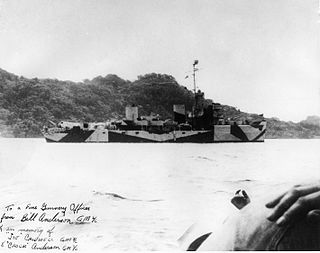
USS Hogan (DD-178) was a Wickes-class destroyer in the United States Navy during World War II. She was the first ship named for Seaman Daniel Hogan.

USS Naifeh (DE-352) was a John C. Butler-class destroyer escort in service with the United States Navy from 1944 to 1960. She was sunk as a target in 1966.

USS Hissem (DE-400/DER-400) was an Edsall class destroyer escort of the United States Navy. She was named for Joseph Hissem.
USS Sims (DE-154/APD-50), a Buckley-class destroyer escort of the United States Navy, was named in honor of Admiral William Sowden Sims (1858–1936), who pushed for modernization of the navy. She is the second ship in the United States Navy to be named USS Sims.

USS Reeves (DE-156/APD-52) was a Buckley-class destroyer escort of the United States Navy, named in honor of Chief Petty Officer Thomas J. Reeves (1895–1941), who was killed in action, while serving aboard the battleship California (BB-44) during the attack on Pearl Harbor. For his distinguished conduct to bring ammunition to anti-aircraft guns, he was posthumously awarded the Medal of Honor.
USS Barber (DE-161/APD-57), a Buckley-class destroyer escort of the United States Navy, was named in honor of brother Malcolm, Randolph, and Leroy Barber who were all killed aboard the USS Oklahoma on 7 December 1941. The ship was laid down in April 1943 and launched one month later, but because the Barber brothers' mother was not available on the day of launching, the ship was christened at the same time that she was commissioned in October 1943. After a year of service in the Atlantic escorting convoys and helping to sink German submarine U-488, Barber was converted to a Charles Lawrence-class high speed transport and assigned the new hull code of APD-57. After her conversion was complete in January 1945, Barber sailed for duty in the Pacific. After earning three battle stars for her wartime service, Barber was decommissioned in March 1946 and placed in reserve.

USS Otter (DE-210), a Buckley-class destroyer escort of the United States Navy, in service from 1944 to 1947. She was finally sunk as a target in 1970.
USS Hubbard (DE-211/APD-53), a Buckley-class destroyer escort of the United States Navy, was named in honor of Commander Joseph C. Hubbard (1900-1942), who was killed in action, while serving aboard the heavy cruiser USS San Francisco (CA-38) during the Naval Battle of Guadalcanal on 13 November 1942.
USS Hayter (DE-212/APD-80), a Buckley-class destroyer escort of the United States Navy, was named in honor of Lieutenant Commander Hubert M. Hayter (1901–1942), who was killed in action, while serving aboard the cruiser USS New Orleans during the Battle of Tassafaronga on 30 November 1942. Lieutenant Commander Hayter was serving as damage control officer when New Orleans received a torpedo hit, and as Central Station, his battle post, filled with asphyxiating gas he ordered all men without masks to leave the compartment giving his own to a partially stricken seaman. After clearing the compartment of all personnel, Lt. Cmdr. Hayter was finally overcome by the fumes. For this extraordinary act of heroism he was posthumously awarded the Navy Cross.

USS Solar (DE-221), a Buckley-class destroyer escort of the United States Navy, was named in honor of Boatswain's Mate First Class Adolfo Solar (1900–1941), who was killed in action during the Japanese attack on Pearl Harbor on 7 December 1941.

I-58 was a Japanese B3 type cruiser submarine that served in the final year of World War II. Modified to carry Kaiten manned torpedoes, she damaged two enemy destroyers with them, but her most significant success was USS Indianapolis, sunk with conventional torpedoes on 30 July 1945. The submarine surrendered in September 1945, and was later scuttled by the United States Navy.

USS Frament (DE-677/APD-77) was a Buckley-class destroyer escort in the United States Navy. She was named for Pharmacist's Mate Third Class Paul S. Frament (1919–1942), who was posthumously awarded the Silver Star for heroism in the Guadalcanal campaign.

USS Savage (DE-386) was an Edsall-class destroyer escort built for the United States Navy during World War II.

USS Velocity (AM-128) was an Auk-class minesweeper acquired by the United States Navy for the dangerous task of removing mines from minefields laid in the water to prevent ships from passing. She was the second warship to bear the name.

USS Andres (DE-45) was an Evarts-class destroyer escort constructed for the United States Navy during World War II. Sent off to the dangerous waters of the North Atlantic Ocean during the Battle of the Atlantic to protect convoys and other ships from Nazi Germany's Kriegsmarine U-boats and fighter aircraft, Andres performed escort and anti-submarine operations.

USS Seid (DE-256) was an Evarts-class destroyer escort of the United States Navy in service from 1943 to 1945. She was scrapped in 1947.
USS Cockrill (DE-398) was an Edsall-class destroyer escort built for the United States Navy during World War II. She served in the Atlantic Ocean and the Pacific Ocean and provided protection against submarine and air attack for Navy vessels and convoys.

USS Oliver Mitchell (DE-417) was a John C. Butler-class destroyer escort built for the United States Navy during World War II. She was named for 2nd Lieutenant Oliver Mitchell, a pilot who posthumously received the Silver Star for his attack on a Japanese destroyer during the Guadalcanal campaign.

USS Tweedy (DE-532) was a John C. Butler-class destroyer escortin service with the United States Navy from 1944 to 1946 and from 1952 to 1969. She was sunk as a target in 1970.

USS Ray K. Edwards (APD-96), ex-DE-237, was a United States Navy high-speed transport in commission from 1945 to 1946.















